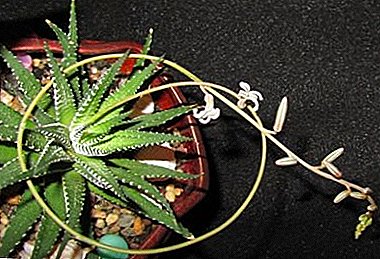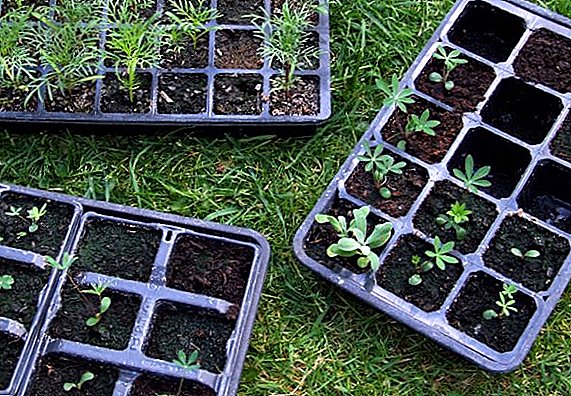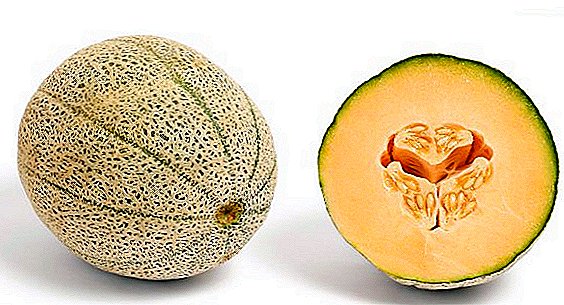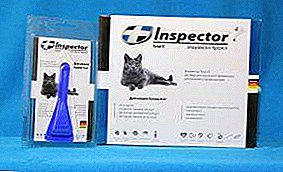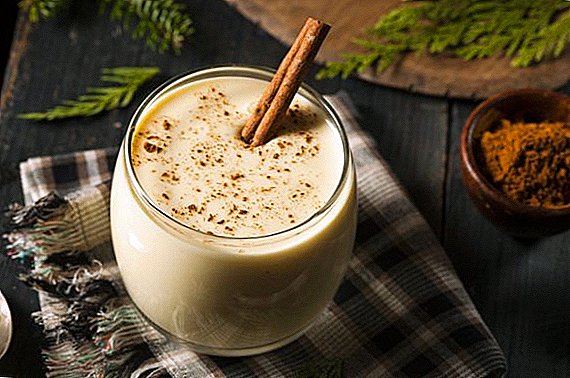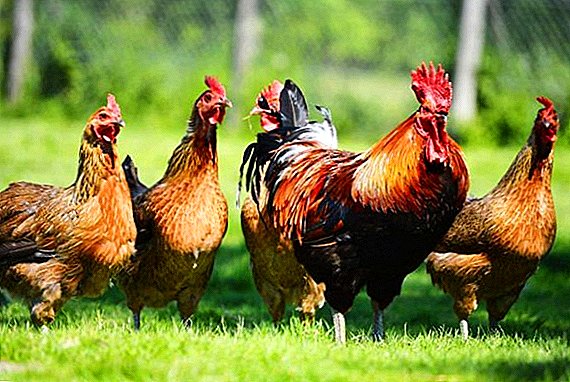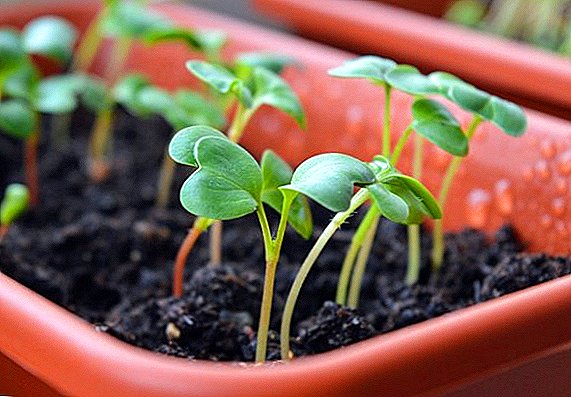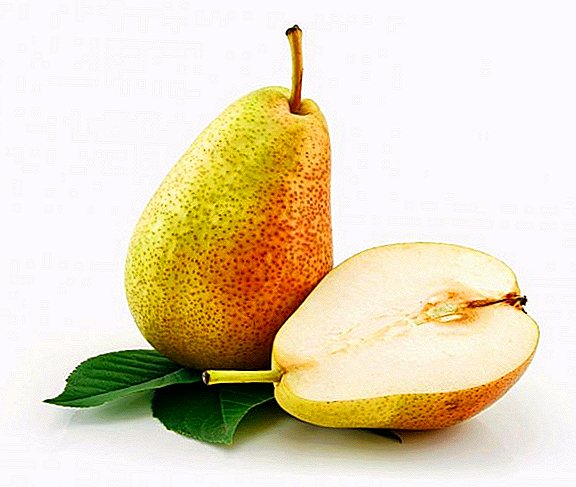 Among the wide variety of pears, the most noticeable variety "Russian beauty".Its productivity, unpretentiousness and resistance to diseases are especially attractive to gardeners and summer residents. A fragrant, juicy and sweet pears will find application in all sectors of the food industry.
Among the wide variety of pears, the most noticeable variety "Russian beauty".Its productivity, unpretentiousness and resistance to diseases are especially attractive to gardeners and summer residents. A fragrant, juicy and sweet pears will find application in all sectors of the food industry.
Breeding history
The variety "Russian Beauty" was bred at the All-Russian Research Institute of Genetics and Breeding of Fruit Plants (VNIIGiSPR) named after Michurin I. V. under the guidance of an outstanding breeder Semen Fedorovich Chernenko. As a result of the crossing of Bere Ardanpon (Ferdinant) and Daughter Blankova varieties, a new pear variety was created, named after its creator, Beauty Chernenko.
Check out the most popular pear varieties: Permyachka, Dukhmyanaya, Belorusskaya Tsentralnaya, Tenderness, Petrovskaya, In Memory of Zhigalov, Otradnenskaya, Avgustovskaya Dew, Detskaya and Rogneda.

Included in the State Register of breeding achievements of Russia and zoned in the Central region since 1996.
Despite regionalization, the pear “Beauty Chernenko” is widely distributed in the territories of the North Caucasus, the Lower Volga region, Ukraine, Belarus, the countries of Transnistria and Central Asia. 
Tree description
The description of the Russian Beauty pear is not significantly different from other pear varieties, but it has some characteristic features.
Tree:
- vigorous (5 m in height);
- crown shape is narrow, elongated, conical.
- brown with a chocolate tint;
- flat and smooth.
Shoots:
- brown-red color;
- sparse;
- smooth, slightly articulated. On branches there are multiple small formations (lentils); growth of the top directivity.

Important! For the formation of the correct form of the crown in the first 5 years of growth, pear branches must be bent back from the stem by 50°.Kidney:
- large and voluminous;
- clinging to shoots;
- cone-shaped.
- dark green color;
- wide with a wedge-shaped base;
- slightly concave as a result of a developed central vein;
- elongated, with small notches on the edges.

Fruit Description
The fruit is tightly attached to a thick, long and curved stem.
To characterize the fruit of the pear can be as follows:
- form - large, elongated, pear-shaped, with a characteristic tuberosity;
- color - uniform green, with a slight blurry reddish blush. At the onset of removable maturity, the color changes to yellow, with a bright burgundy blush;
- skin - dense, with a small wax raid;
- pulp - whitish, juicy, not dense;
- seeds - elongated, small, brown;
- the taste is sweet, slightly sour, without astringency.
 Fruit weight can vary in the range from 160 to 250 g and depends on the availability and quality of agricultural practices (spring pruning).
Fruit weight can vary in the range from 160 to 250 g and depends on the availability and quality of agricultural practices (spring pruning).Did you know? Pear fruits are widely used in alternative medicine recipes as a general tonic for the nervous system and in the fight against stress.
Lighting Requirements
"Russian Beauty" prefers protected from the wind, well-clarified and sunny areas. Southern, southwestern and southeastern areas will be suitable for planting. 
In order to avoid shading, it is necessary to avoid close growth and keep at least 4 m when planting.
Soil requirements
"Russian Beauty" prefers to grow in light and loose soils. Will positively affect the development of the tree and clay content in the soil, it will contribute to moderate retention and absorption of moisture.
Preference is given to weakly acid soils (pH 5.7-6). Such growing weeds, such as: mint, plantain, horsetail, pikulnik, heather, buttercups, may indicate a high acidity of the soil. 

Lower high acidity will help lime application. The calculation of lime applied depends on the degree of acidity of the soil (measured by garden litmus paper).
Important! Injectable 500 g of lime for every 10 square meters. m will increase the level of acidity at 0.2 pH.Periodic loosening of the soil around the perimeter of the growth of the root system will help improve the permeability of the soil and will contribute to the proper exchange of moisture.

Pollination
Pear "Russian Beauty" is self-bearing and does not require pollinators for fruiting. But to achieve maximum yield, as additional pollinators, you can land near medium flowering varieties: "Muscovite", "Bere Moskovskaya", "Lada Amur", "Favorite Yakovlev".
Fruiting
The life span of a pear can reach 50 years, the period of active fruiting is from 15 to 30 years and depends on the quality and regular care.
Full fruiting comes 6-8 year of life. 
Flowering period
Blossom "Beauty Chernenko" accounts for the period The end of May is the beginning of June. On different parts of the tree, the bud of the flower buds comes at different times. So, first the flowering begins on short fruit branches (kolchatka), then on the accessory to the bearing branch (spears) and, finally, flowering begins on all annual shoots.
Depending on climatic conditions, the flowering time may vary. 
Did you know? The beginning of flowering is the amount of color on the tree, exceeding 25%, and its end is the fall of 75% of the color.
Gestation period
The removable maturity of pear "Beauty Chernenko" falls on The end of August - the beginning of September. About the onset of maturity shows yellowing color of the fruit. The rental period lasts 5-7 days.
Harvesting ripe harvest begins with the outer lower branches with a gradual increase, and then a recess to the center. Such an approach will protect the lower fruits from damage by the drop from the upper branches. 
Separating the pear stem from the branch should be a gradual bend with the upward direction and avoid sharp separation with sharp jerks to the bottom. To avoid damage and maintain a high degree of keeping quality, for harvesting it will be more profitable to use special fruit collecting bags.
Caution: Strong finger pressure on the pear can cause darkening and the presence of dark spots on the fruit.
Yield
The main advantage Pear "Beauty Chernenko" is its high yield, increasing with the maturity of the tree. 
Regular annual fertilizing with mineral fertilizers (potash, phosphorus, nitrogen) will help to maintain yield indicators at a high level.
Important! With a lack of mineral substances, the fruits of pears become sour, and the flesh becomes friable and brown, with a large number of stony cells in it.
Mineral fertilizers are usually used and applied as solutions or, in wet seasons, poured directly into the ground. 
Transportability and storage
Fruit well tolerated transportation. Assessment is an average indicator, since the pear is ripe, the softer it is and the more susceptible it is to defects.
It is necessary to store pears in dark cool rooms. Favorable temperature for storage is from 0 ° C to +3 ° C. Storage time depends on the temperature of the room and fluctuates in the range of 1.5-2 months.
In order to maximize the time and to preserve the fruits as much as possible, when packing the crop in tare (better if it is wooden / wicker boxes), pear layers can be poured with a layer of dry sawdust or hay. 

For optimal long-term storage, an important step will also be sorting pears Pears with no signs of any diseases with a whole stalk and smooth skin are subject to the longest preservation.
Fruits with some defects are not long-term preserved and should be used first.
Resistance to environmental conditions and diseases
Research and agricultural observations have shown that this variety resistant to spring frosts and is able to recover quickly (branches and flowers). The tree also tolerates a small and short-lived drought, but this affects the taste and quality of the fruit. 
Important! From lack of moisture, the skin of the fruit gets a bitter taste.Lack of nutrients in the soil will affect the development of the tree and fruit, but is not detrimental to its viability.
Despite the high resistance of the variety to various diseases, the tendency to them persists. Diseases develop only in conditions of high humidity (rainy summer) or from an oversupply of watering. 
For "Russian Beauty" are typical of these diseases:
- powdery mildew - manifested by the appearance of a gray bloom on fruits and shoots, with time the bloom forms many black dots;
- brown spot - manifested by the appearance of large, gradually increasing, brown spots;
- fruit rot - manifested by the appearance of rapidly spreading dark spots with gray-cream dots in the center.

In order to prevent and combat it is necessary to use drugs of fungicidal action ("Chorus", Bordeaux mixture, Bordeaux liquid).
The variety is resistant to all sorts of pests, but, like any fruit tree, it can be attractive to the pear sawfly, the brown fruit mite, the pear sucker, the midge. For pest control are suitable insecticides such as: "Zolon", "Metathion", "Nexin". 
Did you know? Red and black elderberry, planted near the pear, is an excellent deterrent plant for all sorts of pests.
Drought tolerance
Variety "Beauty Chernenko" does not apply to drought-resistant fruit trees and prefers regular watering in the spring-summer season - at least 5 waterings per season. In especially dry seasons the number of waterings to increase.
When irrigating, the most favorable method of sprinkling is to irrigate not only the near part of the tree, but also the upper part of the crown (imitation of rain). 
At high humidity of weather conditions, additional watering is not necessary. Due to excess moisture, the fruit can deform and crack.
Winter hardiness
Pear "Russian Beauty" is not resistant to low temperatures and requires additional techniques for wintering.
To protect the root system, warming of the trunk circle with a thick layer of mulch (sawdust, hay, compost) will help. The trunk may be protected by wrapping it with any non-woven material (for example, roofing felt). The abundance of snow regularly stalked to the trunk is also will increase resistance to frost. 
Did you know? The level of winter resistance will be able to increase the timely processing of the tree with biostimulants during the growing season.
Fruit use
Due to their high palatability, pears are the most relevant and useful for eating unchanged: fresh, dried or canned. But despite this, the fruits are widely used in cooking as candied fruits, compotes, jams, jams, jam, marshmallows, juices, kvass.
Also added as an additional ingredient in various meats, salads, desserts or alcoholic beverages. 
The content of nutrients and vitamins makes pear a frequent component in cosmetology as additives in masks, creams, tonics.
In addition to the pear, in cosmetology, you can also use cherry, hazel, nasturtium, savory, marigold, linden, purslane, periwinkle, momordika, walnuts and veronica drug.
Advantages and disadvantages
"Beauty Chernenko" - hybrid variety. Hybrids become the result of crossing, are displayed to achieve certain parameters. The virtues thus cultivated are redistributed equally with disadvantages. 
pros
The "pluses" include:
- fast growth;
- tasty fruits;
- self-fertility;
- unpretentious care;
- high yield;
- disease resistance.

Minuses
The "cons" include:
- tall;
- the need for constant crown formation;
- the fragility of the wood, susceptibility to breaking branches;
- low winter hardiness;
- late fruiting;
- non-one-dimension fruit.

Did you know? The growth of new branches in the "Russian Beauty" can reach 1 m per year.
Pear "Beauty Chernenko" - quite a popular variety grown in the middle lane. Despite the simplicity, cultivation requires compliance with some features. And to achieve maximum yield, a number of agrotechnical techniques are required. The variety has some drawbacks and is grown mainly by amateurs. The main advantage of "Russian Beauty" can rightly be called high taste of fruits.Watch the video: Pear FORCED to Play - TOCA KITCHEN! (December 2024).





